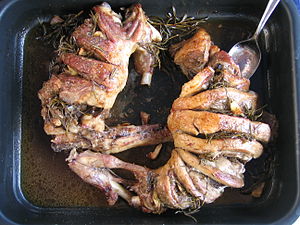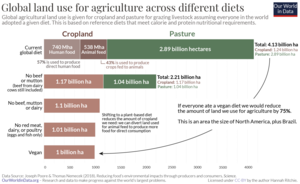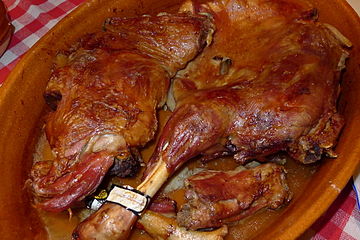Lamb and mutton/ja: Difference between revisions
Created page with "== 精肉と料理 == <gallery mode="packed" heights="160"> File:Plato de lechazo, Valladolid.jpg|''Lechazo asado''(子羊のロースト)は、バリャドリッド県の郷土料理およびその他のカスティーリャ地方の料理である(スペイン)。 File:Chuletillas-El-Mazuco.jpg|アストゥリアスのミルクラムの..." |
|||
| Line 57: | Line 57: | ||
ラム肉は生後1か月から1年の子羊から得られ、枝肉重量は{{convert|5.5|and|30|kg|lb|abbr=on}}である。この肉は一般に成羊の肉より柔らかく、いくつかの[[:en:Western countries|西洋諸国]]の食卓により多く上る。ホゲットとマトンは、種特有の脂肪酸濃度が高いためラムよりも風味が強く、それを好む人もいる。マトンとホゲットは結合[[tissue maturation/ja|組織の成熟]]によりラムより硬くなる傾向があり、そのため[[Lancashire hotpot/ja|ランカシャーホットポット]]のような[[casserole/ja|煮込み料理]]に適している。 | ラム肉は生後1か月から1年の子羊から得られ、枝肉重量は{{convert|5.5|and|30|kg|lb|abbr=on}}である。この肉は一般に成羊の肉より柔らかく、いくつかの[[:en:Western countries|西洋諸国]]の食卓により多く上る。ホゲットとマトンは、種特有の脂肪酸濃度が高いためラムよりも風味が強く、それを好む人もいる。マトンとホゲットは結合[[tissue maturation/ja|組織の成熟]]によりラムより硬くなる傾向があり、そのため[[Lancashire hotpot/ja|ランカシャーホットポット]]のような[[casserole/ja|煮込み料理]]に適している。 | ||
ラム肉はしばしば[[wikt:forequarter|フォークォーター]]、[[loin/ja|ロイン]]、[[wikt:hindquarter|ハインドクォーター]]の3種類に分類される。フォークォーターには首、肩、前脚、肩甲骨までの肋骨が含まれる。ハインドクォーターには後脚と腰が含まれる。ロインはその間の肋骨部分を指す。 | |||
<div lang="en" dir="ltr" class="mw-content-ltr"> | <div lang="en" dir="ltr" class="mw-content-ltr"> | ||
Revision as of 16:47, 25 August 2025


ラム肉とマトン、総称して羊肉(またはシープミート)は、世界で最も一般的な肉の一つであり、家羊 Ovis aries から得られ、一般的に、生後1年以内の羊から得られるラム、2年目の羊から得られるホゲット、それ以上の年齢の羊から得られるマトンに分けられる。一般的に、「ホゲット」と「羊肉」という語は、ノルウェー、ニュージーランド、南アフリカ、スコットランド、オーストラリア以外の消費者には用いられない。ホゲットは、特にイングランド北部(ランカシャーおよびヨークシャー)でより一般的になりつつあり、希少品種や有機農業と関連していることが多い。
南アジア料理やカリブ料理において、「マトン」はしばしばヤギ肉を意味する。様々な時代や地域において、「マトン」や「ゴートマトン」がヤギ肉を意味する場合があった。
ラム肉は3種類の中で最も高価であり、近年では羊肉は「ラム」としてのみ販売されることが増え、上述の区別が曖昧にされることもある。より強い風味を持つマトンは、多くの地域で入手が困難になっており、イギリスのMutton Renaissance Campaignによる普及活動にもかかわらず、その状況は続いている。オーストラリアでは、肉用に飼育されたラムを指す語としてプライムラムがよく用いられる。フランス語、スペイン語、イタリア語などの言語では、羊肉を年齢や場合によっては性別や飼料に応じて同様、もしくはさらに詳細に区別しており、例えばスペイン語のlechazoは母乳で育てられた(離乳していない)子羊の肉を指す。
分類と命名

ラム、ホゲット、マトンの定義は国によって大きく異なる。若いラムは小さく、肉質が柔らかい。マトンは2年以上の羊の肉であり、肉質が硬い。一般的に、色が濃いほど動物が年を取っている。
イギリス、オーストラリア、ニュージーランド
- ラム
- 生後1年未満の若い羊。2019年7月1日から、オーストラリアにおける定義は「(a) 12か月未満である、または (b) 永久切歯が摩耗していないヒツジ」とされた。この新しい定義により、オーストラリアの農家は「ラム」と呼べる期間を1か月延長できるようになった。これは2018年のニュージーランドにおける定義変更に続くものである。イギリスでは依然として「永久切歯が0本」という定義である。永久切歯が摩耗している(in wear)とは、それが隣接する乳歯より突き出している場合を指す。
- ホゲット
- 永久切歯が2本以下で摩耗している羊(性別を問わない)。この語はその羊の肉を指すのにも用いられる。イギリスでは11~24か月齢の羊を指し、オーストラリアの精肉業者は13~24か月齢の羊に用いる。農業や専門精肉業者の間では依然として一般的だが、イギリス、オーストラリア、ニュージーランドのスーパーマーケットでは、2年未満の羊の肉はすべて「ラム」と呼ばれる傾向があり、ホゲットという語は稀である。
- マトン
- 永久切歯が2本以上摩耗している雌(雌羊)または去勢された雄(去勢羊)の肉。
イタリア

ロマネスコ方言において、まだ授乳中もしくは離乳直後の子羊はアバッキオと呼ばれ、すでに2回毛刈りされたほぼ1歳の子羊はagnello(lit. 'ラム')と呼ばれる。この区別はロマネスコ方言にのみ存在する。アバッキオはイタリア中部全域で復活祭やクリスマスの料理として食される。これは欧州連合によりPGIマークで保護された製品である。
イタリア中部全域、特にサルデーニャを含む地域において、牧畜は主要な肉の供給源であった。古代から、アバッキオはラツィオ州の主食の一つであり、特に農村地域の人々にとって食卓での消費量は多かった。アバッキオの消費の伝統は、古代には主に成羊が屠殺される場所に広まった。アバッキオの屠殺は復活祭とクリスマスの期間および6月までしか許されなかった。食材としての重要性から、ラツィオでは羊肉を調理する100種類近いレシピが発展した。社会生活におけるアバッキオの重要性から、現在でもラツィオ州ではサグラと呼ばれる祭りや農村祭、民俗行事が開催されている。古代においては、羊肉は畑仕事の際に食され、アバッキオは復活祭の休日にのみ食べられていた。
南アジア

「マトン」という語は南アジアのほとんどの国でヤギ肉を指し、ヤギの飼育数は増加している。例えば、マトンカレーは常にヤギ肉で作られる。毎年ヤギの3分の1以上が屠殺され、マトンとして販売されていると推定されている。インドおよびインド亜大陸の家羊の数は40年以上減少傾向にあり、山岳地帯において野生羊を基にした品種がわずかに残っており、主に羊毛生産のために飼育されている。
しかし、インドの一部の州(例えばアーンドラ・プラデーシュ州やテランガーナ州)では羊肉も人気がある。
アメリカ合衆国
20世紀初頭には、マトンはアメリカ合衆国で広く消費されていたが、第二次世界大戦以降、マトンの消費は減少した。2010年当時、アメリカ合衆国で流通している羊肉のほとんどは12~14か月齢の羊から得られ、「ラム」と呼ばれている。「ホゲット」という語は用いられない。USDA等級は羊の年齢だけではなく、他の要素によっても決まる。20か月齢までの動物であっても、他の条件次第では「USDAプライム」等級に達することがあり、「USDAチョイス」ラムは年齢を問わない。「スプリングラム」はUSDAによって3月から10月の間に屠殺されたものと定義されている。
その他の種類

- 吸乳子羊またはミルクラム
- 離乳していない子羊の肉で、通常4~6週齢、体重5.5~8kg程度。アメリカやイギリスなどでは一般に入手できない。スペインでチュレティージャスとして知られる小さなラムチョップの炭火焼きや、レチャソ・アサードまたはコルデロ・レチャル・アサードとして知られるローストは、一般に成長したラムよりも風味や食感が優れていると考えられ、高値で取引される。これが見られるスペイン北部の地域には、アストゥリアス、カンタブリア、カスティーリャ・イ・レオン州、ラ・リオハ州が含まれる。ミルクラムは特にギリシャでの復活祭に重宝され、串焼きにされる。
- 若いラム
- 生後6~8週齢の母乳で育ったラム
- スプリングラム
- 通常、生後3~5か月齢で、冬の終わりから春に生まれ、(北半球では)7月1日以前に販売されるラム
- サッカーラム
- オーストラリアで用いられる語で、若いミルクラムや、母乳に依存している生後約7か月までのやや成長したラムを含む。これらの枝肉の重量は通常14~30kgである。離乳後、まだマトンに成長していないラムは「オールドシーズンラム」と呼ばれる。
- 1歳羊(イヤリングラム)
- 生後12~24か月齢の羊
- ソルトブッシュマトン
- オーストラリアで、アトリプレックス植物を放牧して育てた成熟したメリノ種の肉を指す語
- ソルトマシュラム
- (saltmarsh lamb またはフランス語のagneau de pré-saléとしても知られる)潮の干満で覆われる沿岸の塩性湿地で、シーフェンネル、スパルタ草、スイバ、ハマボウフウなどの塩分耐性草本を食べて育った羊の肉。湿地の場所によって植物の種類は微妙に異なる。ソルトマシュラムはフランスで長く珍重されており、イギリスでも人気が高まっている。イギリスでソルトマシュラムが飼育されている地域には、ウェールズのハーレックやガワー半島、サマセット・レベルズ、モーカム湾、ソルウェー湾がある。
- ソルトグラスラム
- フリンダース島(タスマニア)特有のラム。島の牧草は比較的高い塩分を含み、ソルトマシュラムに似た風味と食感を持つ。
精肉と料理
ラム肉は生後1か月から1年の子羊から得られ、枝肉重量は5.5 and 30 kg (12 and 66 lb)である。この肉は一般に成羊の肉より柔らかく、いくつかの西洋諸国の食卓により多く上る。ホゲットとマトンは、種特有の脂肪酸濃度が高いためラムよりも風味が強く、それを好む人もいる。マトンとホゲットは結合組織の成熟によりラムより硬くなる傾向があり、そのためランカシャーホットポットのような煮込み料理に適している。
ラム肉はしばしばフォークォーター、ロイン、ハインドクォーターの3種類に分類される。フォークォーターには首、肩、前脚、肩甲骨までの肋骨が含まれる。ハインドクォーターには後脚と腰が含まれる。ロインはその間の肋骨部分を指す。
Lamb chops are cut from the rib, loin, and shoulder areas. The rib chops include a rib bone; the loin chops include only a chine bone. Shoulder chops are usually considered inferior to loin chops; both kinds of chops are usually grilled. Breast of lamb (baby chops) can be cooked in an oven.
Leg of lamb is a whole leg; saddle of lamb is the two loins with the hip. Leg and saddle are usually roasted, though the leg is sometimes boiled.
Forequarter meat of sheep, as of other mammals, includes more connective tissue than some other cuts, and, if not from a young lamb, is best cooked slowly using either a moist method, such as braising or stewing, or by slow roasting or American barbecuing. It is, in some countries, sold already chopped or diced.
Lamb shank definitions vary, but generally include:
- a cut from the arm of shoulder, containing leg bone and part of round shoulder bone, and covered by a thin layer of fat and fell (a thin, paper-like covering).
- a cut from the upper part of the leg.
Mutton barbeque is a tradition in Western Kentucky. The area was strong in the wool trade, which gave them plenty of older sheep that needed to be put to use.
Thin strips of fatty mutton can be cut into a substitute for bacon called macon.
Lamb tongue is popular in Middle Eastern cuisine both as a cold cut and in preparations like stews.
Cuts
UK, Canada, and other Commonwealth countries

Approximate zones of the usual UK cuts of lamb:
US and Ireland
New Zealand
- Forequarter
- Neck – neck chops
- Shoulder – shoulder chops, shoulder roast (usually boned and rolled)
- Rib-eye
- Breast
- Knuckle
- Loin
- Rib-loin – racks, frenched cutlets, spare ribs
- Mid-loin – striploin (backstrap), loin chops
- Tenderloin
- Flap
- Full leg – leg roast (may be boned and rolled), leg chops. A short-cut leg is a full leg without the chump; a carvery leg is a short-cut leg without the thick flank
- Chump (rump) – chump chops, rump steak
- Thick flank (knuckle) – schnitzel
- Topside & silverside – steaks
- Shank
Production and consumption figures
Sheep meat consumption
According to the OECD-FAO Agricultural Outlook for 2016, the top consumers of sheep meat in 2015 were as follows: EU countries are not individually surveyed in this list. Among EU nations, Greece is the per capita leader in consumption at 12.3 kg, while the UK's annual per capita lamb consumption is 4.7 kg. Outside of the OECD, the largest per capita consumer overall is Mongolia, with 45.1 kg.
Sheep meat production
The table below gives a sample of producing nations, but many other significant producers in the 50–120 kt range are not given.
| 2008 | 2009 | 2010 | 2011 | 2012 | |
|---|---|---|---|---|---|
World |
8,415 | 8,354 | 8,229 | 8,348 | 8,470 |
| 179 | 197 | 205 | 253 | 261 | |
| 660 | 635 | 556 | 513 | 556 | |
| 79 | 80 | 82 | 84 | 85 | |
| 1,978 | 2,044 | 2,070 | 2,050 | 2,080 | |
| 130 | 126 | 119 | 115 | 114 | |
| 38 | 38 | 38 | 39 | 36 | |
| 91 | 90 | 90 | 90 | 90 | |
| 275 | 286 | 289 | 293 | 296 | |
| 113 | 128 | 113 | 113 | 113 | |
| 170 | 114 | 90 | 104 | 126 | |
| 110 | 116 | 123 | 128 | 128 | |
| 598 | 478 | 471 | 465 | 448 | |
| 145 | 149 | 171 | 172 | 174 | |
| 156 | 164 | 167 | 171 | 173 | |
| 278 | 262 | 240 | 253 | 272 | |
| 124 | 128 | 130 | 130 | 133 | |
| 326 | 307 | 277 | 289 | 275 | |
| 81 | 80 | 76 | 69 | 72 | |
| Source: Helgi Library, World Bank, FAOSTAT | |||||
Dishes


Meat from sheep features prominently in the cuisines of several Mediterranean cultures including Greece, Croatia, Turkey, North Africa, Jordan, and the Middle East, as well as in the cuisines of Iran and Afghanistan. In Greece, for example, it is an integral component of many meals and of religious feasts such as Easter, like avgolemono and magiritsa. It is also popular in the Basque culture, both in the Basque country of Europe and in shepherding parts of the Western United States (where shepherds of Basque descent have been active since the 1850s). In the United States, the Navajo have incorporated mutton and lamb into their traditional cuisine since the introduction of sheep by Spanish explorers and settlers in the 17th century, replacing wild turkey and venison and creating a pastoral culture. In Northern Europe, mutton and lamb feature in many traditional dishes, including those of Iceland, Norway and the United Kingdom.
Mutton is also popular in Australia. Lamb and mutton are very popular in Central Asia and in certain parts of China, where other red meats may be eschewed for religious or economic reasons. Barbecued mutton is also a specialty in some areas of the United States (chiefly Owensboro, Kentucky) and Canada. However, meat from sheep is generally consumed far less in the US than in many European, Central American and Asian cuisines; for example, average per-capita consumption of lamb in the United States is only 400 grams (14 oz) per year.
In Australia, the leg of lamb roast is considered to be the national dish. Commonly served on a Sunday or any other special occasion, it can be done in a kettle BBQ or a conventional oven. Typical preparation involves covering the leg of lamb with butter, pushing rosemary sprigs into incisions cut in the leg, and sprinkling rosemary leaves on top. The lamb is then roasted for two hours at 180 °C (350 °F) and typically served with carrots and potato (also roasted), green vegetables and gravy.
In Indonesia, lamb is popularly served as lamb satay Both dishes are cooked with various spices from the islands, and served with either rice or lontong. A version of lamb and bamboo shoot curry is the specialty of Minang cuisine, although similar dishes can be found in Thai cuisine.
In Mexico, lamb is the meat of choice for barbacoa, in which the lamb is roasted or steamed wrapped in maguey leaves underground.
In Japan, although lamb is not traditionally consumed in most of the country, on the northern island of Hokkaido and in the northeastern Tohoku regions, a hot-pot dish called jingisukan (i.e. "Genghis Khan") is popular. In that dish, thin-sliced lamb is cooked over a convex skillet alongside various vegetables and mushrooms in front of the diners, then dipped in soy-sauce-based dipping sauces and eaten. It was so named because lamb is popular in Mongolia (see "Sheep meat consumption" above).
Organ meats/offal
Lamb's liver, known as lamb's fry in New Zealand and Australia, is eaten in many countries. It is the most common form of offal eaten in the UK, traditionally used in the family favourite (and pub grub staple) of liver with onions, potentially also with bacon and mashed potatoes. It is a major ingredient, along with the lungs and heart (the pluck), in the traditional Scottish dish of haggis.
Lamb testicles or lamb fries are a delicacy in many parts of the world.
Lamb kidneys are found in many cuisines across Europe and the Middle East, often split into two halves and grilled (on kebabs in the Middle East), or sautéed in a sauce. They are generally the most highly regarded of all kidneys.
Lamb sweetbreads are a delicacy in many cuisines.
Environmental impact
| Food Types | Land Use (m2year per 100g protein) |
|---|---|
| Beef | 50
|
| Lamb and Mutton | 20
|
| Cheese | 11
|
| Pork | 7.6
|
| Farmed Fish | 6
|
| Poultry | 5.7
|
| Eggs | 4.2
|
| Tofu | 2
|
| Groundnuts | 1.2
|
| Peas | 0.4
|

Production of lamb emits more greenhouse gas per gram of protein than other common foods, except for beef.

関連項目
- Lechazo de Castilla y León/ja – スペイン産の乳汁で育てられたラム肉
- List of lamb dishes/ja
- マトンカレー
- Mutton flaps/ja
- Goat meat/ja
- Sheep's trotters/ja
- Smalahove/ja – 羊の頭を使ったノルウェー西部料理
書誌
- K.F. Warner, "Boning Lamb Cuts", Leaflet 74, U.S. Department of Agriculture, Bureau of Animal Industry, June 1931. full text
- Bob Kennard, "Much ado about mutton". Ludlow: Merlin Unwin, 2014
外部リンク
| この記事は、クリエイティブ・コモンズ・表示・継承ライセンス3.0のもとで公表されたウィキペディアの項目Lamb and mutton(8 August 2025, at 21:56編集記事参照)を翻訳して二次利用しています。 |









